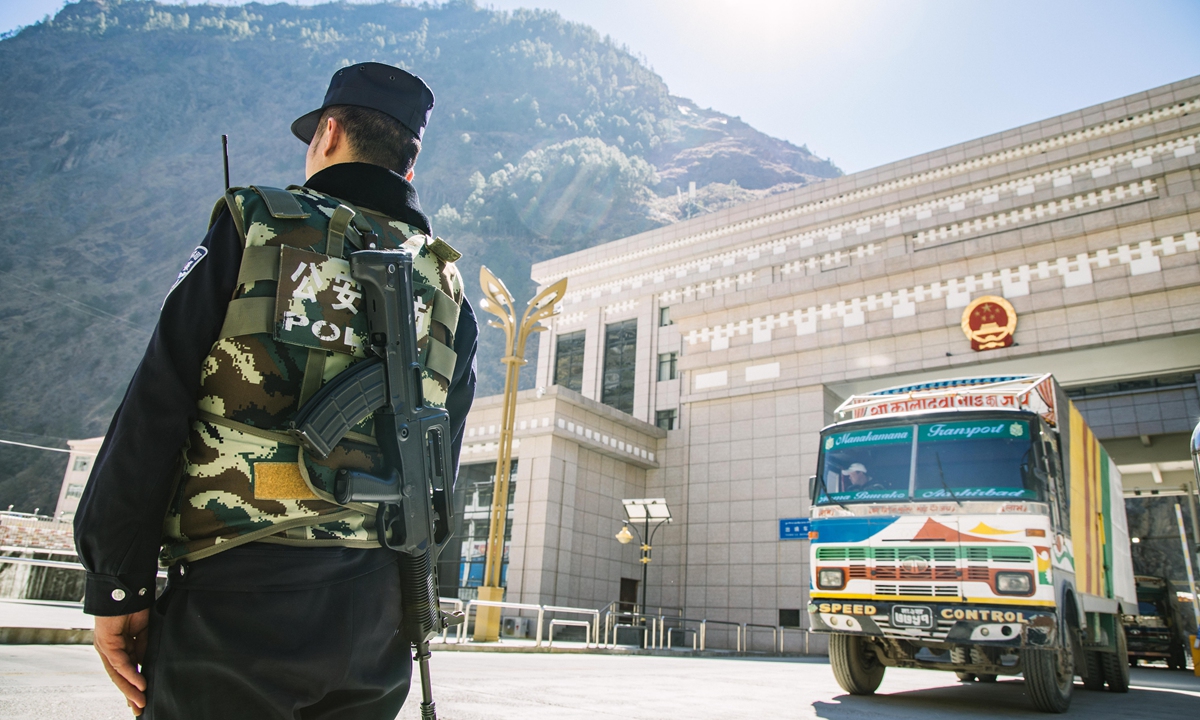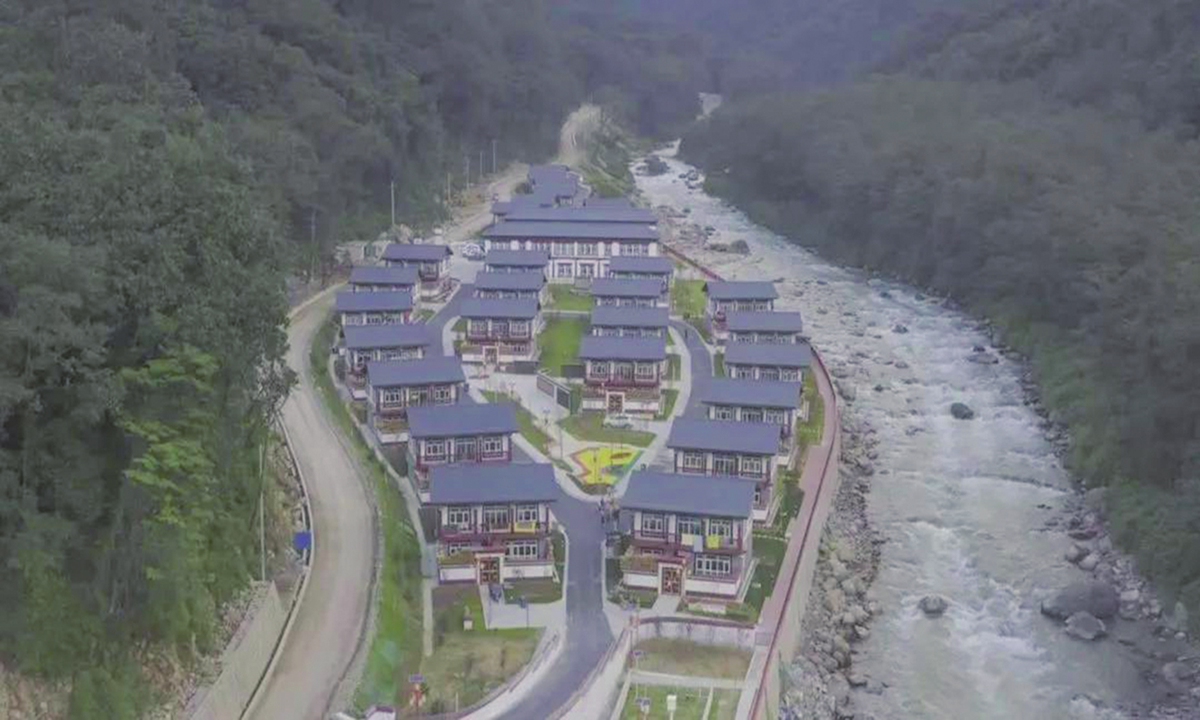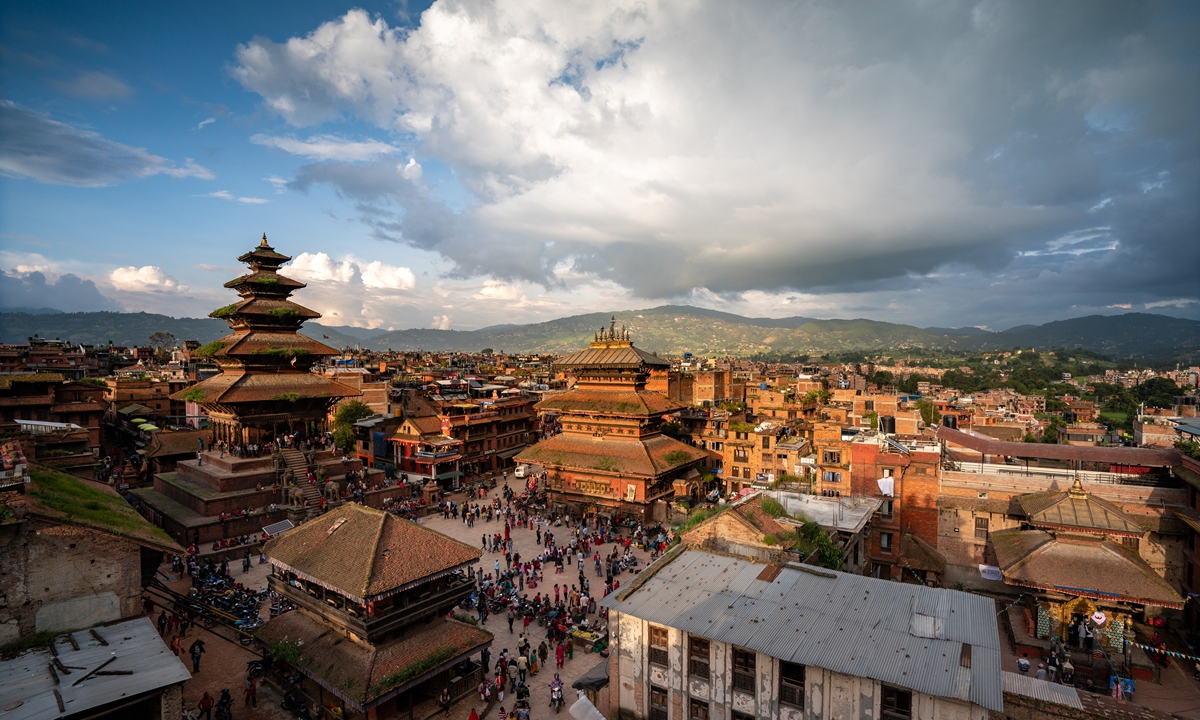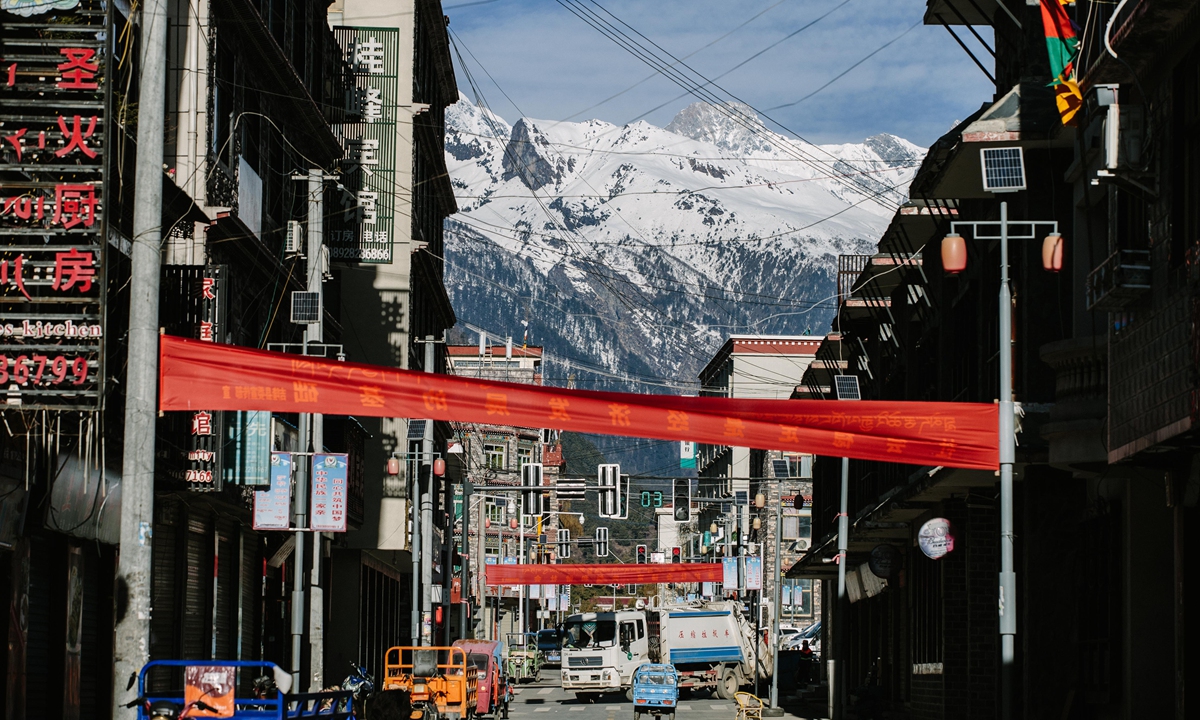GT investigates: China-Nepal, China-Bhutan border disputes rumors 'stoked by India forces'
By GT staff reporters Source: Global Times Published: 2020/11/24 23:18:40 Last Updated: 2020/11/24 22:36:40

Border police guard Gyirong Port on the China-Nepal border, while a truck from Nepal passes the port. Photo: Li Hao/GT
Editor's Note:
A spate of fabricated, hyped China-Nepal and China-Bhutan border disputes is raising concerns about looming foreign forces backing the China-bashing campaign across Himalayas. Local observers and insiders reached by the Global Times see foreign hands as the source of false territory encroachment allegations and defamation against China. Experts say such sources are likely Indian political factions who see both Nepal and Bhutan as its protectorates.
Local observers and experts criticized the Indian media for spreading such rumors. Analysts said some Indian media reports lack self-discipline and hype topics to cater to the nationalist sentiment amid intense press competition, calling such media a "poison" for regional peace and stability.
Instead of pursuing the truth with journalism ethics, some Indian media outlets fabricate lies to draw attention and this has become their habitual way of reporting, analysts said.

Pangda village, Yadong County of Southwest China's Tibet Autonomous Region Photo: Screenshot of Tibet TV
Bhutanese border management controlled by India
Some Indian media recently hyped a Chinese village existed two kilometers inside Bhutanese territory, a claim proven to be false and denied by Bhutanese officials.
Indian media NDTV reported on Thursday the Chinese had built a residential area within Bhutanese territory and named it "Pangda village." But the satellite images and documents showed the village was without a doubt inside Chinese territory. Vetsop Namgyel, Bhutan's envoy to India, also publicly denied the existence of a Chinese village in its territory.
"A lot of information in the Indian media is false. They are making every effort to drive a wedge between China and Bhutan," a Bhutan resident, who preferred to be called Kelly, told the Global Times on Tuesday.
However, most Bhutanese didn't know they are fake news, because 70 percent of Bhutan's local television channels are carrying Indian programming, Kelly said.
Wangcha Sangey, a legal consultant for the Bhutanese news portal bhutannewsnetwork.com, published several articles denouncing India's involvement in the issues of Sino-Bhutanese border demarcation, saying China's negotiation with Bhutan on the border dispute is beneficial for the demarcation of the boundary between the two sides, while India's involvement is an act of surrendering sovereignty to another nation.
According to Sangey, from the late 1960s and through the 1970s, the Indian government tried to negotiate on behalf of Bhutan with China over the issue of China-Bhutan border demarcation.
After being rejected by China, India continued to press Bhutan in the subsequent border negotiations, demanding that Bhutan ask China for more territory of strategic significance.
In 2017, the Indians crossed into Chinese territory under the pretext of "protecting Bhutan" and provoked an incident in the Doklam area.
Sangey commented that India just used Bhutan to secure New Delhi's interest and although Bhutan was reluctant to get involved, in many cases, they have to play the role of India's interest agent in the Sino-Bhutan border dispute.
The Global Times reporter tried to interview Sangey amid a visit to Bhutan in 2017 during the continuously escalating Doklam standoff. The intermediary contacted for the interview initially said Sangey was willing to be interviewed, but could not talk about the situation and relationship between China and India due to the potential repercussions.
But by the time the reporters arrived in Bhutan, Sanjay could no longer be reached. "A gag order may have been received," The intermediary said.
The Global Times found that in Haa district, the town closest to the Doklam confrontation area on the Bhutanese side of the border between China and Bhutan, Indian troops have been stationed for more than half a century. Haa district - home to 13,000 - had more than 500 Indian soldiers in its district capital alone.
Local residents were also not allowed to discuss the Sino-Indian conflict or trade with China. To make a living, they had to import Chinese goods from Nepal or even smuggle them.
China has settled its land boundary lines with 12 neighboring countries through peaceful negotiations since 1949, accomplishing the demarcation work of 90 percent of its borders.
In 2019, China invited all neighboring countries to join an international conference on boundary cooperation, attracting officials and scholars from 12 of China's neighbors.
Letho Tobdhen Tangbi, representative from Bhutan, delivered a speech during the conference, saying that Bhutan and China have kept communications on border issues.
But India, one of the only two countries that have not settled land boundary lines with China, did not show up.
"Under its 'confused confidence,' India can't tolerate the influence of China, or even the US, to rise in the South Asia. India bears the great-nation chauvinism in the region," Hu Zhiyong, a research fellow at the Institute of International Relations of the Shanghai Academy of Social Sciences, told the Global Times on Tuesday.
Indian media can always propagate fake news to smear China. Contrary to what the Indian government has been imagining, China does not see India as an enemy or target, let alone "the ruler of South Asia," Hu said.

Bhaktapur, on the outskirts of Kathmandu, Nepal Photo: IC
Pro-India forces behind China-Nepal dispute rumors
The China-Bhutan border dispute rumors followed false allegations of China trespassing Nepalese land. The rumor started in October and was widely hyped up by Western and Indian media. Media reports claiming that China has annexed more than 150 hectares of Nepalese land have been proven false by repeated investigations from China, Nepal and both countries' foreign ministries.
The allegation cited the conclusion of a politically motivated team that accused China of encroaching on Nepal's territory in the border district after their 11-day visit to Nepal-China border in Humla district in October.
The team was led by Nepali Congress (NC) Parliamentary leader Jeevan Bahadur Shahi, a former government minister widely regarded by the local public as a "blind supporter" of US policy. His party Nepali Congress supported the team's findings in the media and is the largest opposition party in the Nepali House of Representatives and the National Assembly, and is also considered a pro-India force.
Jeevan Bahadur Shahi on Sunday said he felt threatened after China responded aggressively to a report by his team, which showed the "communist nation had encroached on Nepal's land in Humla."
"I want to reiterate that China will be responsible if anything unfortunate happens to me," Shahi said in an interview on local news platform Khabarhub.
"Shahi is the one to provoke the Nepal-China border issues. Government has made clear many times that there is no border encroachment from China. Shahi is just greeting some media hype because here are also some forces that don't want Nepal-China relations good," an anonymous Nepali journalist who closely follows the matter told the Global Times on Tuesday.

A business street in Gyirong town, China-Nepal Border's Gyirong County in Southwest China's Tibet Autonomous Region Photo: Li Hao/GT
Jeevan Bahadur Shahi has registered and run a social organization named Snow-land Integrated Development Center, financially supported by the US. Shahi has been developing another similar organization which mobilizes against China on behalf of the US and Indian governments, a Nepali political observer told the Global Times on Tuesday.
Insiders have confirmed that some staffers in the Indian embassy are supporting some young members of the Nepal Samajbadi Party (Nepal Socialist Party), a unified party of several groups known to be pro-India, to organize street demonstrations near the Chinese embassy, a source close to the matter told the Global Times on Tuesday on condition of anonymity. Such activities have increased since the India-China face-off. One can assume, accordingly, the Indian embassy officials might have used NC leaders to speak out against China, said the source.
Some initiators of demonstrations have close ties with the 14th Dalai Lama and his "government-in-exile," and often organize some parliament members' visits to the Dalai Lama in India. Some have become more explicit in Kathmandu to accuse China after China-India border conflict escalated, said the source.
Nepali Ambassador to China Mahendra Bahadur Pandey told the Global Times in a previous interview that there used to be some long, outstanding territorial problems between Nepal and India. He said some Indian media reports are not based on facts and adopt a biased attitude. Pandey said cooperation between China and Nepal is natural and friendly.
The border disputes have long existed, but tensions have grown louder in 2020 because India's disputes with China and Pakistan on border have upgraded, Qian Feng, director of the research department at the National Strategy Institute at Tsinghua University, told the Global Times on Tuesday.
The Indian media take the chance to hype "Chinese expansionism," Qian said. "They want to create an image in world public opinion that India has been bullied by China, so that the US and other countries would support their policies against China."
The border issue is a card for India to play to acquire domestic support. To hype China-Nepal and China-Bhutan issues, India invents pretexts for the border standoff between India and China by hyping falsified border disputes, Qian noted.
In Nepal and Bhutan, mainstream discourse advocates friendly relations with China, but India would rather keep its influence and pressure on other South Asian countries, according to Qian.
Newspaper headline: Invisible hand
RELATED ARTICLES:
Posted in: IN-DEPTH